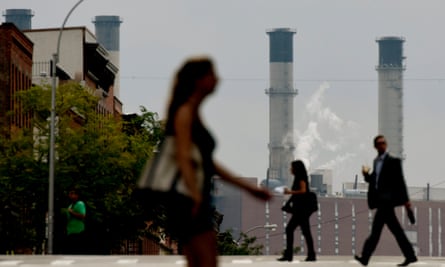During the winter season, many homes in the US are excessively heated, causing residents to open their windows. The reason for this action is…
U
My girlfriend and I used to reside in a steam-heated flat in Manhattan until recently. The building was an old tenement with creaky floors and lacked traditional radiators. Instead, it had scorching hot cast iron pipes that ran through the units like fire poles. These pipes ended a short distance from our ceiling and were connected to valves that emitted a hissing and sputtering sound, often leaking rusty orange water. Not only did they serve as heaters, but they also acted as alarms, making loud clanking noises resembling pots and pans every morning at 6:45am when the basement boiler turned on.
This technology from the 1800s definitely provided heat for our apartment – but it was too much. So every winter, we had to open the windows wide to cool down. My girlfriend enjoyed the contrasting feelings, comparing it to warm pie with ice cream. “It felt like a waste of energy, but it had a pleasant, old-school New York charm,” she said.
According to the non-profit organization Urban Green Council, approximately 80% of residential multifamily buildings in New York City are still heated by steam. This is also the case for millions of homes in the north-east and midwestern regions of the United States, known as the “Steam belt” by the organization. However, with rising energy prices and the urgency of addressing climate change, it is likely that many Americans are unintentionally wasting energy by opening their windows during the winter due to their overly warm homes.
What could possibly be the reason for this?
A significant number of the steam systems in the United States are either too large or not properly adjusted. According to a 2019 study conducted by the Urban Green Council, 73% of individuals living in buildings with steam heating experience consistent overheating. Additionally, 63% of these individuals resort to opening their windows for cooling, but the systems are poorly balanced, resulting in inadequate heat for other residents in the same buildings, as stated in the report. The main concern for policymakers is the pollution caused by these systems: residential buildings contribute the most to carbon emissions in New York City, and the report revealed that 62% of fuel used by multifamily buildings is for heating steam.

In a few weeks, a new law in New York will come into effect, aiming to improve energy efficiency. This will mark the first step towards gradually phasing out steam heating. However, it begs the question – why did it take so long?
According to what I have discovered, Steam has remained popular due to its simplicity. A basement boiler converts water into hot steam, which then travels through pipes and heats up coiled radiators. The radiators release the heat into the surrounding air. The cooled steam condenses back into water and is returned to the boiler by gravity. There is no need for individual temperature controls in each home as the boiler is designed to provide the appropriate amount of steam to each radiator. By maintaining this cycle, everyone can stay warm.
Years of neglect have caused a disturbance to the delicate equilibrium of these systems, and currently no one knows how to repair them. Dan Holohan, a seasoned heating specialist who worked in the 1970s as a salesperson for heating parts, recalls how contractors struggled with steam equipment even during that time. Buildings constructed after World War II had transitioned to more modern methods such as furnaces. Many of the former steam experts were no longer working or had passed away, and Holohan believed that the technology would soon become obsolete.
Intrigued, he started researching old steam heating records and became enamored. He explains, “There was a wealth of American history intertwined with it.” He soon discovered that the pioneers of steam heating were improvising as they went.
Once considered a luxury, and infamous for constantly exploding boilers, steam heating enjoyed a massive surge in popularity around the 1918 flu pandemic. In response to a “fresh air movement” to fight the virus’s spread, crowded tenement buildings installed steam systems that generated enough heat that residents could leave their windows open, even in the dead of winter. “This is why the radiators are as big as they are,” Holohan explains. “And they’re pumping out all this heat to this day.”
During the 1920s and 1930s, there was a period known as the “golden age” of steam heating according to Holohan. After finding a solution to prevent boiler explosions, technicians started creating complex steam systems that were both efficient and strong. They discovered that steam, with its lightweight properties, was the best way to distribute heat to the highest levels of skyscrapers, such as the 102-story Empire State Building. This realization still holds true today, as even modern buildings like New York’s One World Trade Center, completed in 2014, are heated using steam.
According to Holohan, problems with steam heating emerged in the 1970s due to the Opec oil embargo. In response to energy shortages, the government implemented new regulations requiring more efficient boilers. However, many buildings only upgraded their boilers without also replacing their pipes and radiators, causing significant imbalances in the systems. Further complications arose when buildings upgraded to better-insulated windows, resulting in excessive heat retention. Additionally, the passing of the older generation of experts in steam heating left a gap in knowledge transfer to new technicians. Despite these issues, landlords chose to continue with their existing systems rather than investing in a complete overhaul, leaving tenants to tolerate the disruptive noises, gurgling, and unpredictable temperature changes.

For almost 50 years, we have largely adhered to this. However, our efforts are beginning to dwindle. In 2019, New York implemented Local Law 97, a regulation aimed at reducing greenhouse gas emissions from larger buildings in the city. This law will go into effect in two months and will gradually become more stringent until 2050, when the city aims to achieve complete carbon neutrality. This means that the use of steam will soon come to an end. According to Adam Schiabor, research manager for the Urban Green Council, “In order to fully decarbonize New York City, we must eliminate the use of fossil fuels in buildings. However, this is a complex task given the age and diversity of our building stock, so it will require multiple steps.”
The ultimate objective is to have buildings replace their steam systems with electric heat pumps, which are modern and energy-efficient systems that transfer heat between the indoors and outdoors. (I recently moved to a new building that uses heat pumps and the difference in comfort is amazing.) In the meantime, Schiabor suggests that buildings can make simple upgrades to their outdated steam systems, such as installing vents, temperature sensors, and valves to improve performance and give residents more control over indoor temperature. This could potentially allow them to keep their windows closed during the winter. However, some landlords are resistant to these changes. A group of homeowners recently challenged the city’s Local Law 97 for its demanding requirements, but the lawsuit was dismissed by a judge.
Holohan, who is currently 73 years old, supports the recently implemented regulations. However, he believes that steam could be a valuable resource for the city if people were educated on how to properly use it. While still working, Holohan assisted in improving the steam system of a historical building in Manhattan. The system, which featured original and aesthetically pleasing radiators from the 1890s, was both efficient and quiet. Despite their success, the system received little recognition.
Source: theguardian.com

